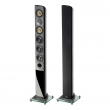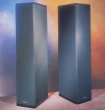Paradigm Eclipse BP Floor standing speakers
Paradigm is a well-known Canadian loudspeaker manufacturer whose diverse product line ranges from inexpensive bookshelf speakers to large systems in the 100-pound/$2,000 class. The company recently introduced a pair of bipolar speakers as part of its new Paradigm Reference brand that are obviously designed for serious audiophile installations. We tested the larger of the systems, the Eclipse/BP. The companion Esprit/BP has a smaller enclosure, smaller drivers, and a smaller price tag, but it is identical in its construction and operating principles.
Although we have tested several bipolar speaker systems recently, for the benefit of new readers let me describe their special qualities. Typically, bipolar speakers consist of two identical groups of low- and high-frequency drivers sharing the same enclosure volume, one group facing forward in conventional fashion and the other group placed directly behind it and facing to the rear. The front and rear outputs are identical and in phase as they leave the speaker. Some larger bipolar systems we have tested recently also contain a single powered subwoofer, but that is not a necessary part of such a speaker system.
Since a bipolar speaker radiates sound from both its front and rear panels, it should typically be placed a foot or more from the wall behind it and preferably 2 or 3 feet from the side wall. As with many conventional speakers, manufacturers of bipolar speakers usually recommend that they be toed in toward the listening position.
The outputs from a bipolar's rear drivers are reflected from the back and side walls before reaching the listener. The resulting time delay relative to the output of the forward-radiating drivers adds a distinctively spacious quality to the sound as the direct and reflected components mingle in the listener's ears.
The Paradigm Eclipse/BP is a columnar tower speaker. Each of its driver complements consists of an 8-inch mica-polymer-cone woofer and a 1-inch aluminum-dome tweeter, with the crossover at 1.5 kHz. The drivers are grouped at the top of the enclosure, placing them about 40 to 46 inches off the floor (approximately ear level for a seated listener).
The cabinet, made of medium-density fiberboard, is extensively braced and extremely rigid (the result of our knuckle-rap test was akin to rapping a concrete block!). There are separate pairs of gold-plated input terminals on the rear panel for the tweeters and woofers to allow for bi-wired or bi-amplified operation. Normally paralleled by jumpers, the terminals accept wires, lugs, or dual banana-plug connectors. The single bass vent for both woofers, flared to minimize turbulence, is located near the bottom of the cabinet's back panel, just above the internal crossover components.
The cabinet sides, finished in flat black, are normally covered completely by a black fabric mesh "sock" that serves as a wrap-around frameless grille. Decorative caps are added to the top and bottom; their standard finish is glossy black, but several wood-veneer finishes are also available. The bottom plate has fittings for the supplied spiked feet. In view of the weight of the speakers, and the need to move them around without damaging our floor or carpet, we did not install the spikes.
We placed the speakers approximately as recommended, 8 feet apart and 3 feet in front of the wall behind them (it was not practical to use Paradigm's suggested 12-inch rear spacing). For listening, they were toed in at an angle such that their axes intersected about 12 feet out from the speakers. For our room-response measurements, the speakers were facing forward, parallel with the side walls.
The room response of the Eclipse/BP, measured with the microphone on the forward axis of the left speaker and about 30 degrees off the axis of the right speaker, was somewhat surprising. It was a good +4 dB from 100 Hz to 20 kHz, but from 50 to 100 Hz it dropped down another couple of decibels, and then it rose 12 dB between 20 and 30 Hz!
Clearly (as other measurements and listening showed), this unexpected behavior was a result of the interaction between the speakers, their placement, and the specific geometry of our listening room. Although practical considerations limited our placement options, other measurements gave a more valid demonstration of the system's bass performance.
The close-miked response of the front woofer (the rear was identical), including the weighted contribution of the port output, was essentially flat from 20 to several hundred hertz. It is difficult, if not impossible, to quantify the response of a pair of bipolar woofers in a more or less normally furnished 15 x 20-foot room, but there was no doubt as to the system's excellence in this area.
That impression was reinforced by the exceptionally low bass distortion of the system, whose sensitivity, rated at 90 dB sound-pressure level (SPL), measured 92 dB at 1 meter with a 2.83-volt input. The (front) woofer distortion at an input corresponding to the rated 90-dB SPL was in the 2- to 3-percent range between 20 and 50 Hz, falling off to a fraction of a percent above 100 Hz.
System impedance ranged between 4 and 10 ohms over the full audio range, which was in line with the Eclipse/BP's nominal 8-ohm rating. There were two impedance maxima, one at 60 Hz and the other at 2.5 kHz.
One of the most impressive aspects of the Eclipse/BP system was the flatness and (relative) smoothness of its frequency response in quasi-anechoic MLS measurements. Though limited to frequencies above 300 Hz, MLS measurements typically produce a somewhat jagged graphical display that is nevertheless repeatable and fairly independent of the effects of room acoustics.
We normally measure the MLS response at distances of 1, 2, and 3 meters from the speaker. The results are usually very similar, with the more distant measurements being somewhat more detailed. The response of the Eclipse/BP was one of the most uniform we have measured in this way. At 3 meters it measured within ±2.5 dB from 300 Hz to 18 kHz. Considering this flat wide-range response in combination with the system's excellent close-miked woofer response and low distortion, the Eclipse/BP's measured performance was exceptional.
It came as no surprise that the system sounded as good as it measured, creating a believable and stable sound-stage (typical of good bipolar speaker systems) that was reasonably independent of the listening position. The deep-bass output (in the 20- to 30-Hz region), though never intrusive when not meant to be, could easily be skin-tingling. My conclusion from testing and living with the Paradigm Reference Eclipse/BP is that its designers have done a superb job, and the result is a truly topnotch speaker. It's not small, not light, and not cheap, but it certainly sounds great!




